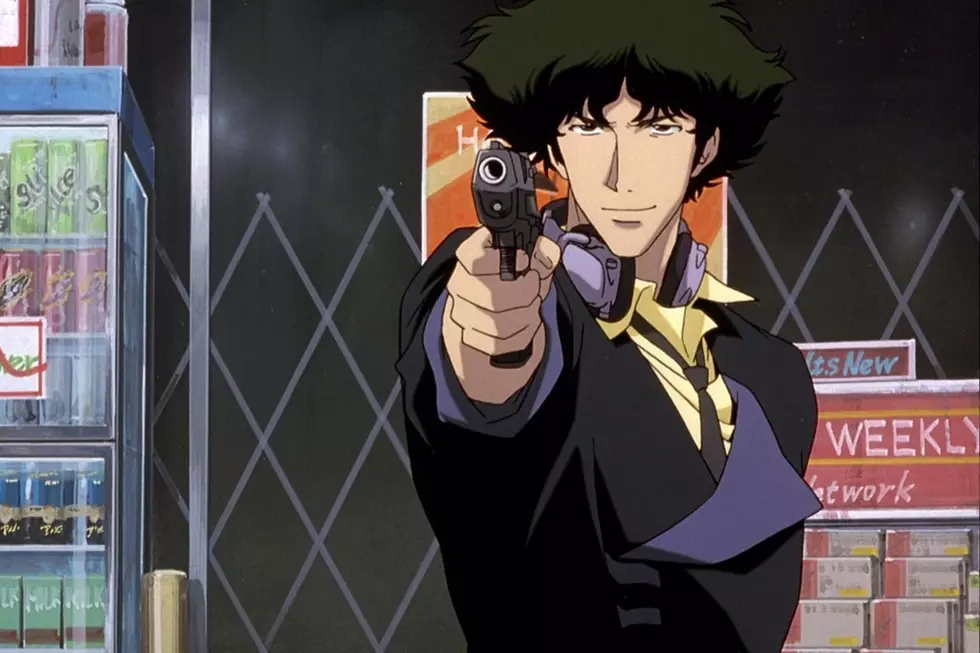
Screen & Page: Let’s Jam With ‘Cowboy Bebop’
Most anime is adapted from manga, often produced by the manga publisher to raise awareness and sell it overseas. But what about the anime shows or film that go the other way, adapted from the screen to the page? How do those works hold up, and what changes or stays the same? That’s what Screen & Page aims to explore.
This week, we're talking about one of the coolest --- and some would say one of the greatest --- anime series ever made, and its two obscure manga spin-offs; Cowboy Bebop!
THE SERIES
Broadly speaking, if you're a Westerner and you're into anime, it's probably because of Cowboy Bebop, created by animation studio Sunrise (under the collective name "Hajime Yayate") and directed by Shinichiro Watanabe in his first solo effort.
Cowboy Bebop is, as ComicsAlliance's own Betty Felon once said, "the better Japanese version of Firefly." That's not a bad assessment; Like Joss Whedon's cult space western, Bebop premiered in 1998 and was jerked around by its original TV network, Tokyo, then unceremoniously cancelled, only to find a second , more profitable life. In this case it was broadcast in full on satellite network WOWOW to great acclaim. It's also one of the cornerstones of Adult Swim in the US.
By "cornerstone," I mean that when Adult Swim broadcast its first night of programming on September 2, 2001, Bebop's pilot episode, "Asteroid Blues," was one of the first things it showed. It's been rerun constantly on the network ever since, and is credited with changing the way Americans thought about anime in the wake of the '90s boom.
Historical context aside, what is the show about? Set in 2071, with Earth uninhabitable after a disaster, humanity's spread to the stars and crime runs rampant. It's a good era to be a bounty hunter, or "cowboy."
Two such cowboys are Spike Spiegel, a moss-haired martial artist with a snazzy suit and a chill attitude, and Jet Black, an ex-cop with a robotic arm and a penchant for bonzai trees. They skate by aboard their ship, the Bebop, with Spike saying "there're three things I can't stand: pets, kids, and women with attitudes." So naturally they find all three. There's the hyperintelligent corgi Ein, the 13-year old androgynous genius hacker Edward, and Faye Valentine, a greedy con artist with a mysterious past she doesn't fully understand.
Over 26 episodes and a 2001 movie, the crew of the Bebop track down all kinds of bounties and their own personal dreams. All set to the best television soundtrack ever made. Seriously, folks. Take a seat and lose yourself in the jazz cool of Yoko Kanno and The Seatbelts:
Although its music is transcendent on its own, Bebop is a truly special show. A blend of action and comedy filtered through a unique Hong Kong-action-meets-Japanese-drama-meets-Western-SF milieu, Bebop's like no other anime before or since. Every episode, planned by Watanabe as a mini-movie, is a treat unto itself, with repeated delights each time you turn back to them.
The characters are fully realized, the action and environments impeccable, and the direction assured and stylized. Bebop is not only a high point in the filmography of Sunrise, but also responsible for famed anime studio BONES (who helped make the Bebop film and Watanabe's 2014 series Space Dandy). The entire world of animation owes this show a debt, and it's worthy of all the accolades it's received.
THE MANGA
Bebop actually has two manga adaptations, both written and drawn by women. The first, Cowboy Bebop: Shooting Star by Cain Kuga, was released in 1997 to promote the series. Its ten monthly chapters in the now-defunct Monthly Fantasy Asuka DX magazine deviate quite a bit from the show. For example, Spike and Jet take Ed aboard first, before Ein or Faye.
The second manga by Yutaka Nanten, simply called Cowboy Bebop, ran in Fantasy Asuka DX from 1998-2000, also for ten chapters. This version plays out more like additional episodes, with stories introduced and resolved in a one-and-done manner.
Although both are short, I prefer Shooting Star. Kuga's art style plays around with the characters a bit more than Nanten does. On top of that, the scrapes Nanten gets the Bebop crew into just aren't that interesting. If anything, her stories --- including one involving Ed's fellow orphan and hacker whiz kid Tomato --- are conventional. And conventional is something that Bebop shouldn't be. Kuga at least takes things in a new and interesting direction.
Still, if what's available on screen doesn't satisfy your Bebop craving, you should check these manga out. Both were licensed in the US by Tokyopop, and copies are cheaply available secondhand. While they're not as great as the show, they're fun, and a good way to spend more time with your favorite space cowboys.
Cowboy Bebop is available streaming on Hulu, Funimation and Adult Swim and is widely available on DVD, Blu-Ray and digital. The mangas are available in print from a variety of retailers and your local library.
More From ComicsAlliance




![Screen & Page: Meet Heaven’s Worst Angels In ‘Panty & Stocking With Garterbelt'[Love & Sex Week]](http://townsquare.media/site/622/files/2017/02/ps.jpg?w=980&q=75)




